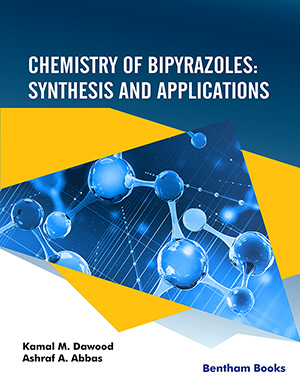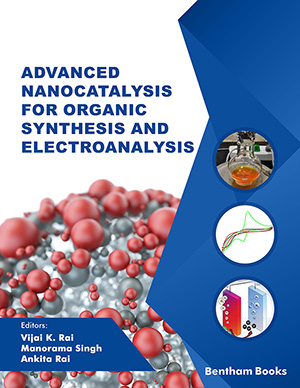
Abstract
Background: Since its discovery on the 1930 decade, phthalocyanines have occupied a prominent place in the textile and dye industries due to their thermal stability, low solubility and reactivity. However, over the last three decades, many different applications have been found for phthalocyanine derivatives including medicine, materials science, catalysis and energy fields. In this review, we discuss about the phthalocyanine chemistry, and the principal synthetic precursors as well. Strategies developed for obtaining soluble and nonaggregated phthalocyanine dyes are also covered, with insights on the reaction mechanisms. The main synthetic methods for the synthesis of symmetric and non-symmetric systems are presented and discussed.
Objective: This review aims to present an overview on phthalocyanine chemistry and their principal synthetic precursors, covering strategies developed for obtaining soluble and non-aggregated phthalocyanine dyes with insights on the reaction mechanisms. Also, the main synthetic methods are presented, and different approaches to symmetric and non-symmetric phthalocyanine are discussed.
Conclusion: Phthalocyanines are compounds with significant applications and growing interest in science. Their physical and chemical properties have been more and more elucidated. The major challenge is to make the synthetic protocols more suitable and cheaper, in order to allow studies and application on large scales.
Keywords: Phthalocyanines, synthesis, monomer precursors, non-aggregation.
Current Organic Synthesis
Title:Soluble and Non-Aggregated Phthalocyanines: Synthesis, Mechanistic Aspects and Their Main Building Blocks
Volume: 14 Issue: 8
Author(s): Nicholas R.S. Gobo, Timothy J. Brocksom and Kleber T. de Oliveira*
Affiliation:
- Departamento de Quimica, Universidade Federal de Sao Carlos, Rodovia Washington Luis, km 235 - SP -310, 13565-905, Sao Carlos, SP,Brazil
Keywords: Phthalocyanines, synthesis, monomer precursors, non-aggregation.
Abstract: Background: Since its discovery on the 1930 decade, phthalocyanines have occupied a prominent place in the textile and dye industries due to their thermal stability, low solubility and reactivity. However, over the last three decades, many different applications have been found for phthalocyanine derivatives including medicine, materials science, catalysis and energy fields. In this review, we discuss about the phthalocyanine chemistry, and the principal synthetic precursors as well. Strategies developed for obtaining soluble and nonaggregated phthalocyanine dyes are also covered, with insights on the reaction mechanisms. The main synthetic methods for the synthesis of symmetric and non-symmetric systems are presented and discussed.
Objective: This review aims to present an overview on phthalocyanine chemistry and their principal synthetic precursors, covering strategies developed for obtaining soluble and non-aggregated phthalocyanine dyes with insights on the reaction mechanisms. Also, the main synthetic methods are presented, and different approaches to symmetric and non-symmetric phthalocyanine are discussed.
Conclusion: Phthalocyanines are compounds with significant applications and growing interest in science. Their physical and chemical properties have been more and more elucidated. The major challenge is to make the synthetic protocols more suitable and cheaper, in order to allow studies and application on large scales.
Export Options
About this article
Cite this article as:
Gobo R.S. Nicholas , Brocksom J. Timothy and de Oliveira T. Kleber *, Soluble and Non-Aggregated Phthalocyanines: Synthesis, Mechanistic Aspects and Their Main Building Blocks, Current Organic Synthesis 2017; 14 (8) . https://dx.doi.org/10.2174/1570179414666170403115907
| DOI https://dx.doi.org/10.2174/1570179414666170403115907 |
Print ISSN 1570-1794 |
| Publisher Name Bentham Science Publisher |
Online ISSN 1875-6271 |
Call for Papers in Thematic Issues
Biorthogonal Chemistry: A translational chemical tool for in vivo applications
After the discovery in 1990, bioorthogonal chemistry encompassed a set of diverse fast-paced selective chemical reactions, facilitating the study of biomolecules under physiological aura without intervening in the biochemical processes. Over the past two decades, significant progress has been witnessed in bioorthogonal reactions such as Staudinger ligation, metal-catalyzed coupling reactions, ...read more
Design and Synthesis of Green Pesticides
The development of green new pesticides is currently one of the hotspots in the field of pesticide research, aiming to develop efficient, environmentally friendly, and safe pesticide products to meet the needs of modern agricultural production. Green new pesticides prioritize environmental friendliness and ecological safety. Therefore, during the research and ...read more
Exploring the Role of Chemical Graph Theory in Advancing Current Organic Synthesis
Organic synthesis is a fundamental discipline in chemistry, crucial for the creation of complex molecules with diverse applications in pharmaceuticals, materials science, and beyond. However, the process of designing efficient synthetic routes for target molecules remains challenging. Chemical graph theory, a branch of theoretical chemistry, offers powerful tools for understanding ...read more
Novel Green Approaches in the Synthesis of Bioactive Molecules
This special issue regards several aspects of green chemistry, focusing on innovative strategies to run organic synthesis reactions in a more environmentally friendly. Interesting articles or reviews about the critical role of green methodologies in reducing the environmental impact of chemical processes are welcome. Moreover, novel methodological studies using sustainable ...read more
Related Journals
 84
84 4
4 1
1 1
1
- Author Guidelines
- Graphical Abstracts
- Fabricating and Stating False Information
- Research Misconduct
- Post Publication Discussions and Corrections
- Publishing Ethics and Rectitude
- Increase Visibility of Your Article
- Archiving Policies
- Peer Review Workflow
- Order Your Article Before Print
- Promote Your Article
- Manuscript Transfer Facility
- Editorial Policies
- Allegations from Whistleblowers
Related Articles
-
Epoxycarotenoids and Cancer. Review
Current Bioactive Compounds Hemicellulose from Plant Biomass in Medical and Pharmaceutical Application: A Critical Review
Current Medicinal Chemistry Haptotactic Gradients for Directed Cell Migration: Stimulation and Inhibition Using Soluble Factors
Combinatorial Chemistry & High Throughput Screening Pharmacokinetic, Dosimetry and Toxicity Study of <sup>177</sup>Lu-EDTMP in Patients: Phase 0/I study
Current Radiopharmaceuticals Novel Concepts in the Development of Platinum Antitumour Drugs: An Update
Medicinal Chemistry Reviews - Online (Discontinued) Insulin-like Effects of Mt. Fuji Subsoil Water which Conta ins Vanadium on Cultured Cells: Insight from Japan
Current Traditional Medicine PI3K/Akt Signalling Pathway Specific Inhibitors: A Novel Strategy to Sensitize Cancer Cells to Anti-Cancer Drugs
Current Pharmaceutical Design Combinatorial Application of Nucleic Acid-Based Agents Targeting Protein Kinases for Cancer Treatment
Current Pharmaceutical Design Applications of Computed Tomography, Magnetic Resonance Imaging and Magnetic Resonance Spectroscopy for Planning External Beam Radiotherapy
Current Medical Imaging The Chemopreventive and Chemotherapeutic Potentials of Tea Polyphenols
Current Pharmaceutical Biotechnology Detection of Tumor Markers with ProteinChip® Technology
Current Pharmaceutical Biotechnology Role of miR-193a in Cancer: Complexity and Factors Control the Pattern of its Expression
Current Cancer Drug Targets In vivo Fluorescence Detection in Surgery: A Review of Principles, Methods, and Clinical Applications
Current Medical Imaging Use of E. coli Purine Nucleoside Phosphorylase in the Treatment of Solid Tumors
Current Pharmaceutical Design Nanoliposome is a Promising Carrier of Protein and Peptide Biomolecule for the Treatment of Cancer
Anti-Cancer Agents in Medicinal Chemistry Identification and Analysis of RNA Editing Events in Ovarian Serous Cystadenoma Using RNA-seq Data
Current Gene Therapy Relevance of the Chronobiological and Non-chronobiological Actions of Melatonin for Enhancing Therapeutic Efficacy in Neurodegenerative Disorders
Recent Patents on Endocrine, Metabolic & Immune Drug Discovery (Discontinued) Recent US Patents on Extracellular Matrix in Tissue Engineering and Regenerative Medicine
Recent Patents on Regenerative Medicine Metallic Colloid Nanotechnology, Applications in Diagnosis and Therapeutics
Current Pharmaceutical Design Radiopharmaceutical Tracking of Particles Injected into Tumors: A Model to Study Clearance Kinetics
Current Drug Delivery

























